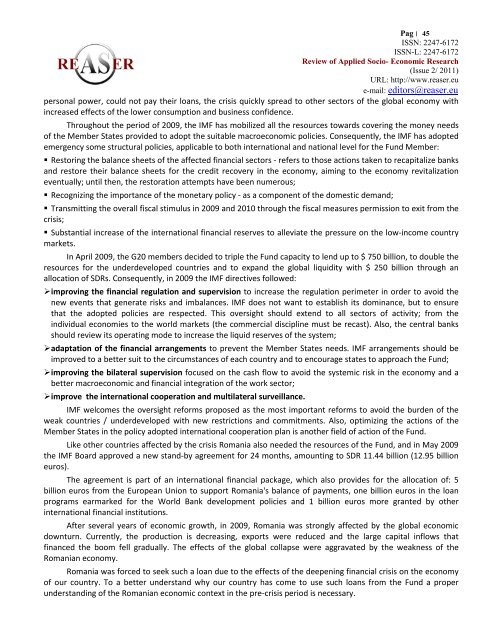Volume 2, ISSUE2/2011 - Review of Applied Socio-Economic ...
Volume 2, ISSUE2/2011 - Review of Applied Socio-Economic ...
Volume 2, ISSUE2/2011 - Review of Applied Socio-Economic ...
You also want an ePaper? Increase the reach of your titles
YUMPU automatically turns print PDFs into web optimized ePapers that Google loves.
Pag׀ 45 ISSN: 2247-6172ISSN-L: 2247-6172<strong>Review</strong> <strong>of</strong> <strong>Applied</strong> <strong>Socio</strong>- <strong>Economic</strong> Research(Issue 2/ <strong>2011</strong>)URL: http://www.reaser.eue-mail: editors@reaser.eupersonal power, could not pay their loans, the crisis quickly spread to other sectors <strong>of</strong> the global economy withincreased effects <strong>of</strong> the lower consumption and business confidence.Throughout the period <strong>of</strong> 2009, the IMF has mobilized all the resources towards covering the money needs<strong>of</strong> the Member States provided to adopt the suitable macroeconomic policies. Consequently, the IMF has adoptedemergency some structural policies, applicable to both international and national level for the Fund Member: Restoring the balance sheets <strong>of</strong> the affected financial sectors - refers to those actions taken to recapitalize banksand restore their balance sheets for the credit recovery in the economy, aiming to the economy revitalizationeventually; until then, the restoration attempts have been numerous; Recognizing the importance <strong>of</strong> the monetary policy - as a component <strong>of</strong> the domestic demand; Transmitting the overall fiscal stimulus in 2009 and 2010 through the fiscal measures permission to exit from thecrisis; Substantial increase <strong>of</strong> the international financial reserves to alleviate the pressure on the low-income countrymarkets.In April 2009, the G20 members decided to triple the Fund capacity to lend up to $ 750 billion, to double theresources for the underdeveloped countries and to expand the global liquidity with $ 250 billion through anallocation <strong>of</strong> SDRs. Consequently, in 2009 the IMF directives followed: improving the financial regulation and supervision to increase the regulation perimeter in order to avoid thenew events that generate risks and imbalances. IMF does not want to establish its dominance, but to ensurethat the adopted policies are respected. This oversight should extend to all sectors <strong>of</strong> activity; from theindividual economies to the world markets (the commercial discipline must be recast). Also, the central banksshould review its operating mode to increase the liquid reserves <strong>of</strong> the system; adaptation <strong>of</strong> the financial arrangements to prevent the Member States needs. IMF arrangements should beimproved to a better suit to the circumstances <strong>of</strong> each country and to encourage states to approach the Fund; improving the bilateral supervision focused on the cash flow to avoid the systemic risk in the economy and abetter macroeconomic and financial integration <strong>of</strong> the work sector; improve the international cooperation and multilateral surveillance.IMF welcomes the oversight reforms proposed as the most important reforms to avoid the burden <strong>of</strong> theweak countries / underdeveloped with new restrictions and commitments. Also, optimizing the actions <strong>of</strong> theMember States in the policy adopted international cooperation plan is another field <strong>of</strong> action <strong>of</strong> the Fund.Like other countries affected by the crisis Romania also needed the resources <strong>of</strong> the Fund, and in May 2009the IMF Board approved a new stand-by agreement for 24 months, amounting to SDR 11.44 billion (12.95 billioneuros).The agreement is part <strong>of</strong> an international financial package, which also provides for the allocation <strong>of</strong>: 5billion euros from the European Union to support Romania's balance <strong>of</strong> payments, one billion euros in the loanprograms earmarked for the World Bank development policies and 1 billion euros more granted by otherinternational financial institutions.After several years <strong>of</strong> economic growth, in 2009, Romania was strongly affected by the global economicdownturn. Currently, the production is decreasing, exports were reduced and the large capital inflows thatfinanced the boom fell gradually. The effects <strong>of</strong> the global collapse were aggravated by the weakness <strong>of</strong> theRomanian economy.Romania was forced to seek such a loan due to the effects <strong>of</strong> the deepening financial crisis on the economy<strong>of</strong> our country. To a better understand why our country has come to use such loans from the Fund a properunderstanding <strong>of</strong> the Romanian economic context in the pre-crisis period is necessary.








